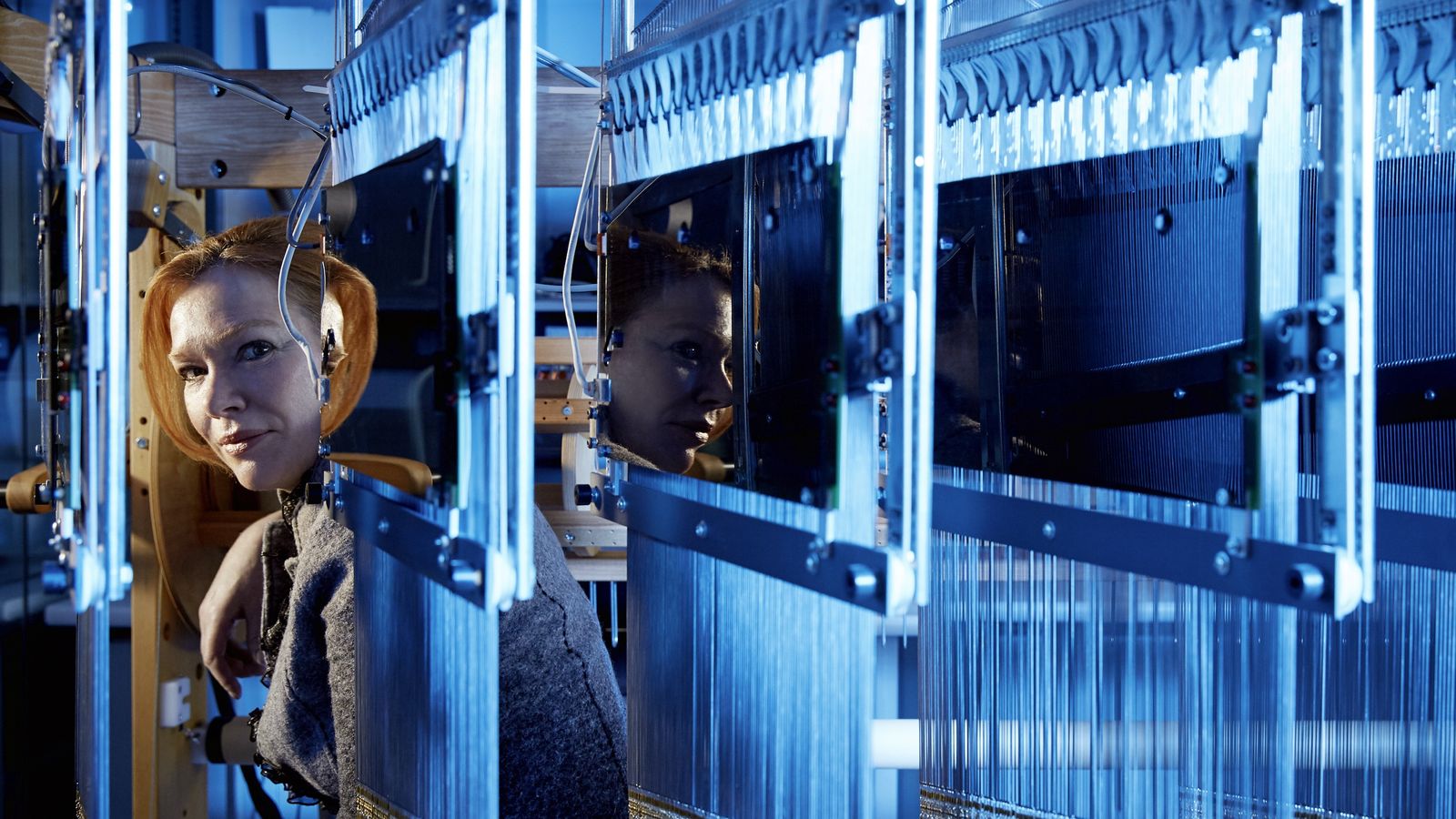Biotextilogy
The Cellular Catwalk

6 October – 15 November
biotextilogy / bʌɪˈɒˈtɛkstʌɪ' lədʒi / The study, design and creation of textiles emulating those made by living organisms
Melissa Knothe Tate with Joanna L. Ng, Lillian E. Knothe, and Sara McBride-Gagyi
We are literally the stuff from which our tissue fabrics and their fibers are woven and spun. The arrangement of collagen, elastin and other structural proteins in space and time embodies our tissues and organs with amazing resilience and multifunctional smart properties. These patterns represents our biotextilogy.
Melissa L. Knothe Tate, 2017 Scientific Reports doi: 10.1038/srep40396
Renaissance engineer Professor Melissa Knothe Tate turns art and science on their heads. Having studied engineering in an era of Computer-Aided Design and Computer-Aided-Manufacturing (CAD-CAM), she has invented a new platform for Microscopy-Aided Design And Manufacture (MADAMe). MADAMe creates scaled-up textiles that mimic the natural cellular weaves of living tissues. Learning from cells, the threads they spin and the tissues they weave. Biotextilogy features multifunctional textile design with hidden functions. Biomedical engineer Professor Melissa Knothe Tate’s work replicates the natural weave of the tissue around human bones, using a Jacquard loom to research into a future of smart materials inspired by nature, where disruptive technology meets design aesthetic.
This transdisciplinary, interactive exhibition presents her multifunctional textiles and smart materials inspired by nature, tying together the fields of biotechnology and textile design on "The Cellular Catwalk."
Our "brainless" cells are expert sensors and prototypers of tissue. Tissues are living textiles that are both created by as well as constantly adapted by their cellular inhabitants. In this way, cells self-assemble multifunctional 'clothes' that are 'appropriate for any weather' or environment.
The cell's blueprints can be scaled up to engineer advanced materials for sportswear, medical devices, as well as the safety and transport industries. Weaving looms, the earliest computers, are used to enlarge the cellular algorithms and manufacture a new generation of adaptive fabrics. Rather than creating patterns of colour to achieve fashion aesthetics, we use patterns of mechanical and other biophysical properties to achieve increased functionality in wearables and devices for external and internal applications.
EXHIBITION EVENT DETAILS
Panel Discussion: Science Inspiring Craft
Thursday 12 October, 6-8pm
Join Melissa Knothe Tate and guests in conversation about her exhibition and how science is inspiring craft.
Drinks from 6pm. Panel discussion starts at 6.30pm.
Artist Talk and Tour: Biotextilogy: The Cellular Catwalk
Saturday 21 October,11.30-12.30pm
Take a guided tour through the Biotextilogy: The Cellular Catwalk exhibition with artist and Professor Melissa Knothe Tate who will discuss her work where science and weaving meet.
Free event, bookings required
School workshops:
School groups of 20 students or less can book the exhibit for three hour time slots, with guided tour of the exhibition (10 students at a time) and interactive "engineering innovation" lab (10 students at a time) experiences included.
School bookings, includes all materials for lab exercise and entry to exhibit for 20 students and up to 5 adults are available for a fee, please contact ADC directly to discuss email hello(at)australiandesigncentre.com or call 02 9361 4555 for more information.
Sponsored tickets available for school groups upon application.
About Melissa Knothe Tate
Professor Melissa Knothe Tate is an internationally recognised leader in the fields of multiscale mechanobiology as well as the development and clinical translation of novel technologies and materials. Trained as a mechanical engineer, biologist and biomedical engineer at world leading institutions in Palo Alto, California and Zurich, Switzerland, Prof. Knothe Tate's work harnesses the power of multiscale imaging and computational modeling technology to navigate complex biosystems, understand nature's paradigms for engineering emergence, as well as to discover, design and manufacture novel materials [1]. She was recently recognised as one of Australia's most Innovative Engineers 2017 for her geospatial and navigation approaches (using Google Maps) to understand the cellular inhabitants of complex biosystems including the human hip. Ironically, prior to that, she was selected for the Christopher Columbus Foundation - U.S. Chamber of Commerce Chairman's Distinguished Life Sciences Award, recognising a "scientist who is making or has recently made a significant and positive contribution related to developing a 'cutting edge' innovation in the field of life sciences."
Her recognition as an elected Fellow of Engineers Australia, the Biomedical Engineering Society, the American Society for Mechanical Engineering, and the American Institute for Medical and Biological Engineering give an indication of her recognition among peers in the top tier of the field. Mentoring and cultivation of talent and innovation are particularly important to Prof. Knothe Tate, who has designed and debuted curricula to engineer innovation with cohorts as diverse as Indigenous children, Harvard engineering undergraduates, and doctoral trainees in multiscale modeling at University of Paris Est.
[1] Knothe Tate ML (2017) Microscopy and the Modern Magellans, Science/AAAS, in press.
Image: Melissa Knothe Tate. Photo credit Nick Cubbin
